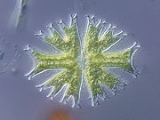
Desmid
Encyclopedia
Desmids are an order
(Desmidiales) of green algae
, comprising around 40 genera
and 5,000 to 6,000 species
, found mostly but not exclusively in fresh water
. Most are unicellular
, and are divided into two compartment
s separated by a narrow bridge or isthmus. Desmids assume a variety of highly symmetrical
and generally attractive shapes, which provide the basis for their classification. Each compartment has one chloroplast
, and no flagella
. Sexual reproduction
occurs through a process of conjugation, also found among the Zygnematales
. These two groups are closely related, and may be united as the division Gamophyta. The desmids are sometimes treated as members of the Zygnematales, but more often given the separate order Desmidiales.
Order (biology)
In scientific classification used in biology, the order is# a taxonomic rank used in the classification of organisms. Other well-known ranks are life, domain, kingdom, phylum, class, family, genus, and species, with order fitting in between class and family...
(Desmidiales) of green algae
Green algae
The green algae are the large group of algae from which the embryophytes emerged. As such, they form a paraphyletic group, although the group including both green algae and embryophytes is monophyletic...
, comprising around 40 genera
Genus
In biology, a genus is a low-level taxonomic rank used in the biological classification of living and fossil organisms, which is an example of definition by genus and differentia...
and 5,000 to 6,000 species
Species
In biology, a species is one of the basic units of biological classification and a taxonomic rank. A species is often defined as a group of organisms capable of interbreeding and producing fertile offspring. While in many cases this definition is adequate, more precise or differing measures are...
, found mostly but not exclusively in fresh water
Fresh Water
Fresh Water is the debut album by Australian rock and blues singer Alison McCallum, released in 1972. Rare for an Australian artist at the time, it came in a gatefold sleeve...
. Most are unicellular
Cell (biology)
The cell is the basic structural and functional unit of all known living organisms. It is the smallest unit of life that is classified as a living thing, and is often called the building block of life. The Alberts text discusses how the "cellular building blocks" move to shape developing embryos....
, and are divided into two compartment
Compartment
In heraldry, a compartment is a design placed under the shield, usually rocks, a grassy mount , or some sort of other landscape upon which the supporters are depicted as standing...
s separated by a narrow bridge or isthmus. Desmids assume a variety of highly symmetrical
Symmetry
Symmetry generally conveys two primary meanings. The first is an imprecise sense of harmonious or aesthetically pleasing proportionality and balance; such that it reflects beauty or perfection...
and generally attractive shapes, which provide the basis for their classification. Each compartment has one chloroplast
Chloroplast
Chloroplasts are organelles found in plant cells and other eukaryotic organisms that conduct photosynthesis. Chloroplasts capture light energy to conserve free energy in the form of ATP and reduce NADP to NADPH through a complex set of processes called photosynthesis.Chloroplasts are green...
, and no flagella
Flagellum
A flagellum is a tail-like projection that protrudes from the cell body of certain prokaryotic and eukaryotic cells, and plays the dual role of locomotion and sense organ, being sensitive to chemicals and temperatures outside the cell. There are some notable differences between prokaryotic and...
. Sexual reproduction
Sexual reproduction
Sexual reproduction is the creation of a new organism by combining the genetic material of two organisms. There are two main processes during sexual reproduction; they are: meiosis, involving the halving of the number of chromosomes; and fertilization, involving the fusion of two gametes and the...
occurs through a process of conjugation, also found among the Zygnematales
Zygnematales
The Zygnematales + νήμα , νήματος ), also called the Conjugales, are an order of green algae, comprising several thousand different species in genera such as the well-known Zygnema and Spirogyra. All the members of this group develop into unbranched filaments, one cell thick, which grow longer...
. These two groups are closely related, and may be united as the division Gamophyta. The desmids are sometimes treated as members of the Zygnematales, but more often given the separate order Desmidiales.
External links
Further reading
- Survey of Clare Island 1990 - 2005, noting the Desmidiales recorded. Ed. Guiry, M.D., John, D.M., Rindi, F. and McCarthy, T.K. 2007. New Survey of Clare Island. Volume 6: The Freshwater and Terrestrial Algae. Royal Irish Academy. ISBN 13: 978-1-904890-31-7

